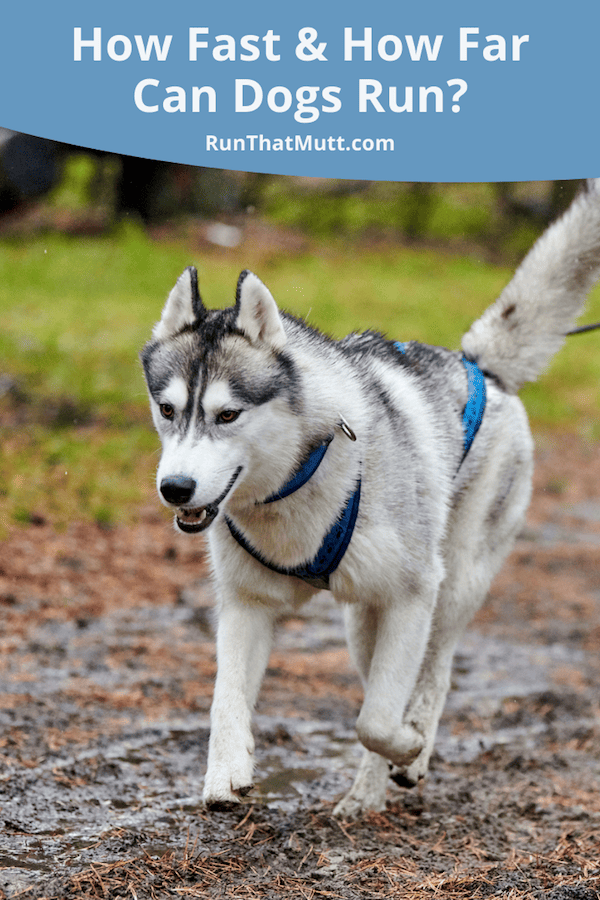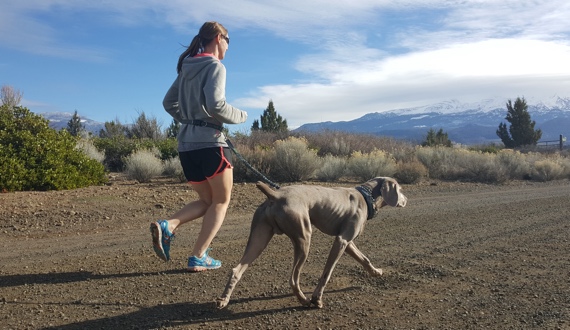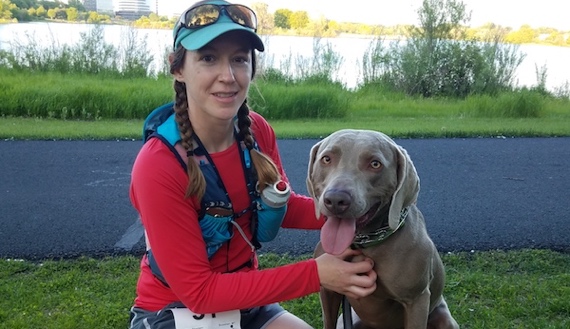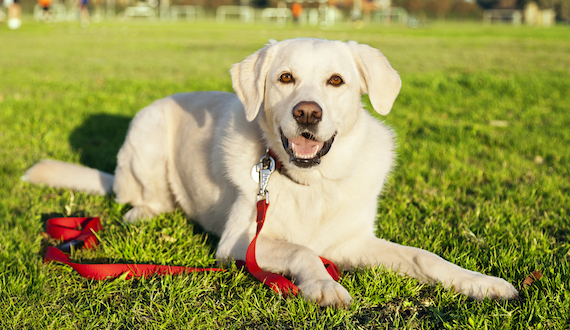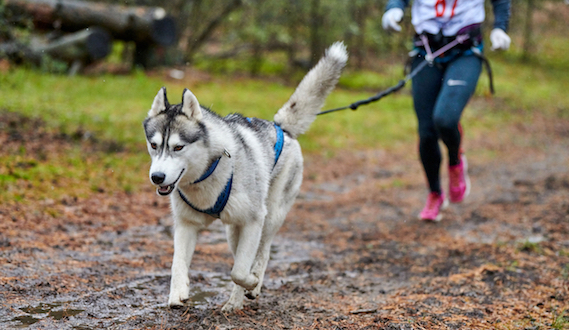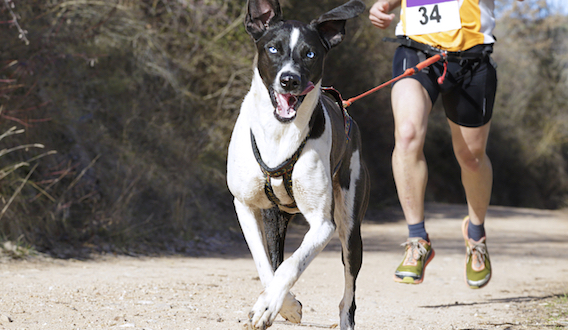
How fast and how far a dog can run depends so much on the unique dog. Every breed is different, but even the dog’s breed is just one factor.
For example, just because most border collies have a lot of endurance does not mean all border collies are good runners. Age, genetics, overall health, the dog’s upbringing and individual personality are also factors.
In this article, I write about how far you can run with your own dog, which dogs make the best running partners and how you can prepare for running a race with your dog.
I also cover how dogs run and what makes most of them so fast.
Table of Contents
How much running is safe for a dog?
I wish there were an easy answer to this question! Even if you ask several veterinarians or breeders, they are all going to have a different opinion.
I’ve been running with different dogs for more than 20 years, starting with my family’s golden retrievers.
Later, I owned an actual business where I took dogs on running sessions. I got to run with hundreds of different types of dogs, and we covered thousands of miles together.
How far a dog can safely run depends so much on the unique dog.
If the dog is in top physical condition and the weather conditions are also perfect, some dogs can easily run further than a marathon, even taking on distances of 50 miles+. Think of sled dogs, for example.
My own running dog is a weimaraner, a hunting breed meant to run through fields all day long.
Remy is happy running 5 to 10 miles in a stretch and has gone on a couple of my marathon training runs in the 15- to 18-mile range. He could go further, of course. And much, much faster than me!
For your average dog with average training, a daily 3- to 5-mile run should be no problem. But it’s best to slowly ease into running if your dog is not used to it.
See our article on tips for running with your dog if you’d like to get started.
What to look for in a dog running partner
A large variety of dogs can make good running partners. Most medium and large, energetic breeds and mixed breeds will enjoy running with you. Think Labs, golden retrievers, border collie, shepherds, pitbulls and vizslas.
Most of the sporting and herding breeds will make good running dogs. A lot of terriers are also great running dogs.
But the right dog running partner for you depends on your running habits.
Do you like to go for a couple of slower, 2-mile runs per week? Or are you always training hard for half marathons or trying to get a PR on your next 10K?
Most dogs are going to tag along no problem for the easy 2-mile runs, but they won’t all be up for longer or faster runs.
Training a dog to run with you
Also think about the trainability and personality of the breeds you’re considering. Breed is just one factor, of course. All dogs are individuals. But in general, some breeds are easier to train than others.
For example, is it important to you to train your dog not to pull on the leash? I’ve had a heck of a time teaching my weimaraner not to pull as he’s bred to be out in front hunting, using his nose.
Other breeds also tend to pull such as Brittany spaniels and huskies. But these dogs can make awesome canicross partners!
Is it important to you to have a dog that can be off leash on trails and stick close? Think about a Lab or a golden retriever that is bred to hunt closer to his person. Border collies also tend to stick closer to their people on trails.
For more details on training your dog to run, see our tips for running with your dog.
Training your dog for a race
We LOVE supporting dog friendly races, and list all of the U.S. races here on our site.
Check out our article on how to prepare your dog for a 5K race. It goes over not just the physical training but how to prepare your dog mentally and socially for the chaos of the noisy race atmosphere.
Dog anatomy & how dogs run
Here are some of the unique features dogs have:
A dog’s paws – built for running:
Their paws are covered in tough, calloused pads. The more you walk and run with your dog on different surfaces, the more their paw pads will adapt to higher mileage and rough terrain.
One of the most common injuries I see while running with dogs is if the dog is not used to being walked on pavement, then they need a couple of weeks to build up tougher pads. If not, then sometimes they scuff up their pads and start bleeding.
A dog’s paw pads also help them grip different types of surfaces, according to MerckVetManual.com. And their nails also give them extra traction while they run.
A dog’s legs:
Dogs have four different gates, according to Merck. Similar to horses, dogs walk, trot, canter and gallop. And they have most of the same muscles, joints and ligaments as we do.
The dog’s coat is a factor:
As you know, dogs’ coats vary widely. Some types of coats are better suited for different types of weather.
For example, huskies and malamutes have thick coats that protect them even in sub zero weather. Retrievers such as Labradors and golden retrievers also have thick coats that protect them from cold water and cold weather conditions.
Dogs with shorter coats like my weimaraner do not have a lot of protection from the cold but their fur still gives them a little protection from the sun and heat.
How a dog keeps cool
Since dogs are not able to sweat like we do, they lose heat by panting. When you’re running with your dog in warm weather, be very mindful of how you will provide water, shade and keep your dog from overheating.
Even when dogs are panting, they still need to pause from panting in order to get a good breath, according to Merck.
I personally do not run with my dog using a Gentle Leader or any sort of head collar that fits over his muzzle because I do not want to prevent him from panting and cooling properly.
You can also help your dog cool off by making sure he drinks water, encouraging swimming or wading or spraying water directly onto his coat.
Dogs that run fast – 45 MPH!
Fastest dog breeds
The greyhound is well known as being one of the fastest breeds overall, able to clock in at 45 mph, according to the Greyhound Club of America. The only land mammal that can run faster than a greyhound is the cheetah.
Other speedy breeds include sighthounds that are similar to greyhounds such as borzois, salukis and Afghan hounds.
Most of the working and sporting breeds are also very fast such as vizslas and border collies. As far as terriers go, the Jack Russell terrier is known for its speed despite being small and short.
Fastest dog and human mile
The fastest recorded mile for a human and dog pair is 4 minutes and 6.2 seconds, set in 2019 by Dan Wehunt and his German shorthair pointer, Odessa. The beat the previous record (set by a weimaraner and his owner) by about 7 seconds.
Endurance dogs covering 50 to 100 miles
Some dogs are bred for endurance over speed (although they’re usually still quite fast too!). The most obvious example is how a husky is bred to run long distances day after day pulling a sled.
The 1,000-mile sled dog race called the Yukon Quest takes place every February for about two weeks. The dogs race between Whitehorse, Yukon and Fairbanks, Alaska, while covering four mountain ranges!
Our partner site ThatMutt.com interviewed one of the participants and he said that his sled dog teams are conditioned to cover 50 to 100 miles in a stretch! They maintain a steady pace around 8 MPH. So we’re not talking greyhound speed!
As another example, hunting breeds such as German shorthair pointers, springer spaniels and vizslas are bred to run around in a field hunting all day. In the right weather conditions, they can be on the go all day.
Dogs that run slow
Some smaller and shorter dogs are not going to enjoy running and they’re definitely not going to be as fast. Some of the slower breeds include pugs, French bulldogs, basset hounds and shitzus.
However, dogs are individuals. There is always going to be an example of a pug who loves to run 10Ks or an English bulldog who loves to run every day.
Do you run with your dog?
In the comments below, let us know what kind of dog you run with!

